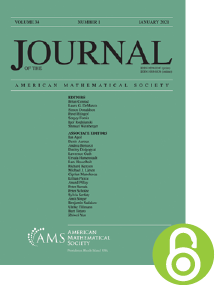On the size of Kakeya sets in finite fields
HTML articles powered by AMS MathViewer
- by Zeev Dvir
- J. Amer. Math. Soc. 22 (2009), 1093-1097
- DOI: https://doi.org/10.1090/S0894-0347-08-00607-3
- Published electronically: June 23, 2008
- PDF | Request permission
Abstract:
A Kakeya set is a subset of $\mathbb {F}^n$, where $\mathbb {F}$ is a finite field of $q$ elements, that contains a line in every direction. In this paper we show that the size of every Kakeya set is at least $C_{n} \cdot q^{n}$, where $C_{n}$ depends only on $n$. This answers a question of Wolff.References
- [AT08]AT08 N. Alon and T. Tao. Private communication. 2008.
- J. Bourgain, N. Katz, and T. Tao, A sum-product estimate in finite fields, and applications, Geom. Funct. Anal. 14 (2004), no. 1, 27–57. MR 2053599, DOI 10.1007/s00039-004-0451-1
- J. Bourgain, On the dimension of Kakeya sets and related maximal inequalities, Geom. Funct. Anal. 9 (1999), no. 2, 256–282. MR 1692486, DOI 10.1007/s000390050087
- J. Bourgain, Harmonic analysis and combinatorics: how much may they contribute to each other?, Mathematics: frontiers and perspectives, Amer. Math. Soc., Providence, RI, 2000, pp. 13–32. MR 1754764, DOI 10.1007/bf02791532
- Roy O. Davies, Some remarks on the Kakeya problem, Proc. Cambridge Philos. Soc. 69 (1971), 417–421. MR 272988, DOI 10.1017/s0305004100046867
- Nets Hawk Katz and Terence Tao, Bounds on arithmetic projections, and applications to the Kakeya conjecture, Math. Res. Lett. 6 (1999), no. 5-6, 625–630. MR 1739220, DOI 10.4310/MRL.1999.v6.n6.a3
- Gerd Mockenhaupt and Terence Tao, Restriction and Kakeya phenomena for finite fields, Duke Math. J. 121 (2004), no. 1, 35–74. MR 2031165, DOI 10.1215/S0012-7094-04-12112-8
- Keith McKenzie Rogers, The finite field Kakeya problem, Amer. Math. Monthly 108 (2001), no. 8, 756–759. MR 1865664, DOI 10.2307/2695620
- J. T. Schwartz, Fast probabilistic algorithms for verification of polynomial identities, J. Assoc. Comput. Mach. 27 (1980), no. 4, 701–717. MR 594695, DOI 10.1145/322217.322225
- Terence Tao, From rotating needles to stability of waves: emerging connections between combinatorics, analysis, and PDE, Notices Amer. Math. Soc. 48 (2001), no. 3, 294–303. MR 1820041
- Terence Tao, A new bound for finite field Besicovitch sets in four dimensions, Pacific J. Math. 222 (2005), no. 2, 337–363. MR 2225076, DOI 10.2140/pjm.2005.222.337
- Thomas Wolff, Recent work connected with the Kakeya problem, Prospects in mathematics (Princeton, NJ, 1996) Amer. Math. Soc., Providence, RI, 1999, pp. 129–162. MR 1660476
- Richard Zippel, Probabilistic algorithms for sparse polynomials, Symbolic and algebraic computation (EUROSAM ’79, Internat. Sympos., Marseille, 1979) Lecture Notes in Comput. Sci., vol. 72, Springer, Berlin-New York, 1979, pp. 216–226. MR 575692
Bibliographic Information
- Zeev Dvir
- Affiliation: Department of Computer Science, Weizmann Institute of Science, Rehovot, Israel
- Email: zeev.dvir@weizmann.ac.il
- Received by editor(s): March 24, 2008
- Published electronically: June 23, 2008
- Additional Notes: Research was supported by a Binational Science Foundation (BSF) Grant.
- © Copyright 2008
American Mathematical Society
The copyright for this article reverts to public domain 28 years after publication. - Journal: J. Amer. Math. Soc. 22 (2009), 1093-1097
- MSC (2000): Primary 52C17; Secondary 05B25
- DOI: https://doi.org/10.1090/S0894-0347-08-00607-3
- MathSciNet review: 2525780


